Recap: Basics of Process Control and Modelling
Advanced Modeling and Control
Why process control
- Importance of process analysis and control
- Process control objectives
- Hirarchy of process control activities
- Overview of control system design
Importance of process analysis and control


- Optimal process operations require efficient and effective control
- Control systems and advanced algorithms are deployed to monitor, regulate, and optimize the process variables.
Process System, Input and Output








Manipulated Variable (MV): The flow rate of the liquid into or out of the tank.
Controlled Variable (CV): Level of the liquid in the tank
Disturbances: Changes in inlet flow rate, changes in outlet flow rate, temperature variations, pressure fluctuations
Unmeasured Output: The temperature of the liquid in the tank
Control objectives
Explicit control objectives (ECOs)
Clearly defined and typically quantifiable goals for the performance of a control system.
These objectives are explicitly stated
Form the basis of the formal design and analysis of control systems
Examples:
Setpoint Tracking, Disturbance Rejection, Stability, Speed of Response, Overshoot Minimization, Regulatory Compliance
Implicit control objectives (ICOs)
Not explicitly stated or quantified
Often evaluated qualitatively
Have a significant long-term impact
Play a crucial role in the successful implementation
Examples:
Simplicity, Reliability, Cost-effectiveness, Safety, Flexibility, Scalability
Control System Design should link the two types of control objectives.
Real plants can have similar ICOs but different ECOs
Implicit control objectives
Safety First
- People
- Environment
- Equipment
Profit
- meeting final product specifications
- minimizing waste production
- minimizing environmental impact
- minimizing energy use
- maximizing overall production rate
Reducing variability
Poor control requires set point far from constraint
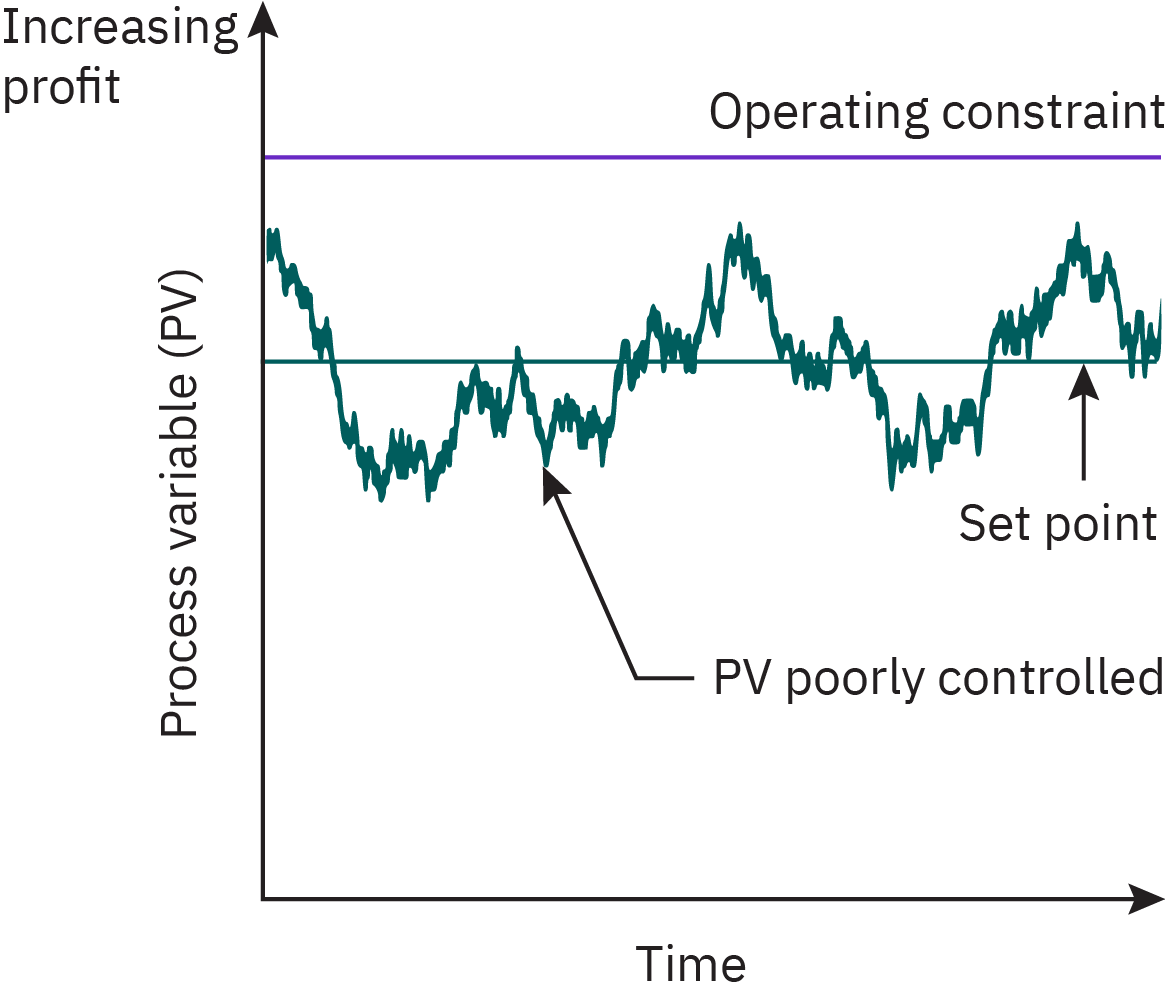
Good control permits set point near constraint

Optimal plant operations






Hirarchy of process control activities







Overview of control system design
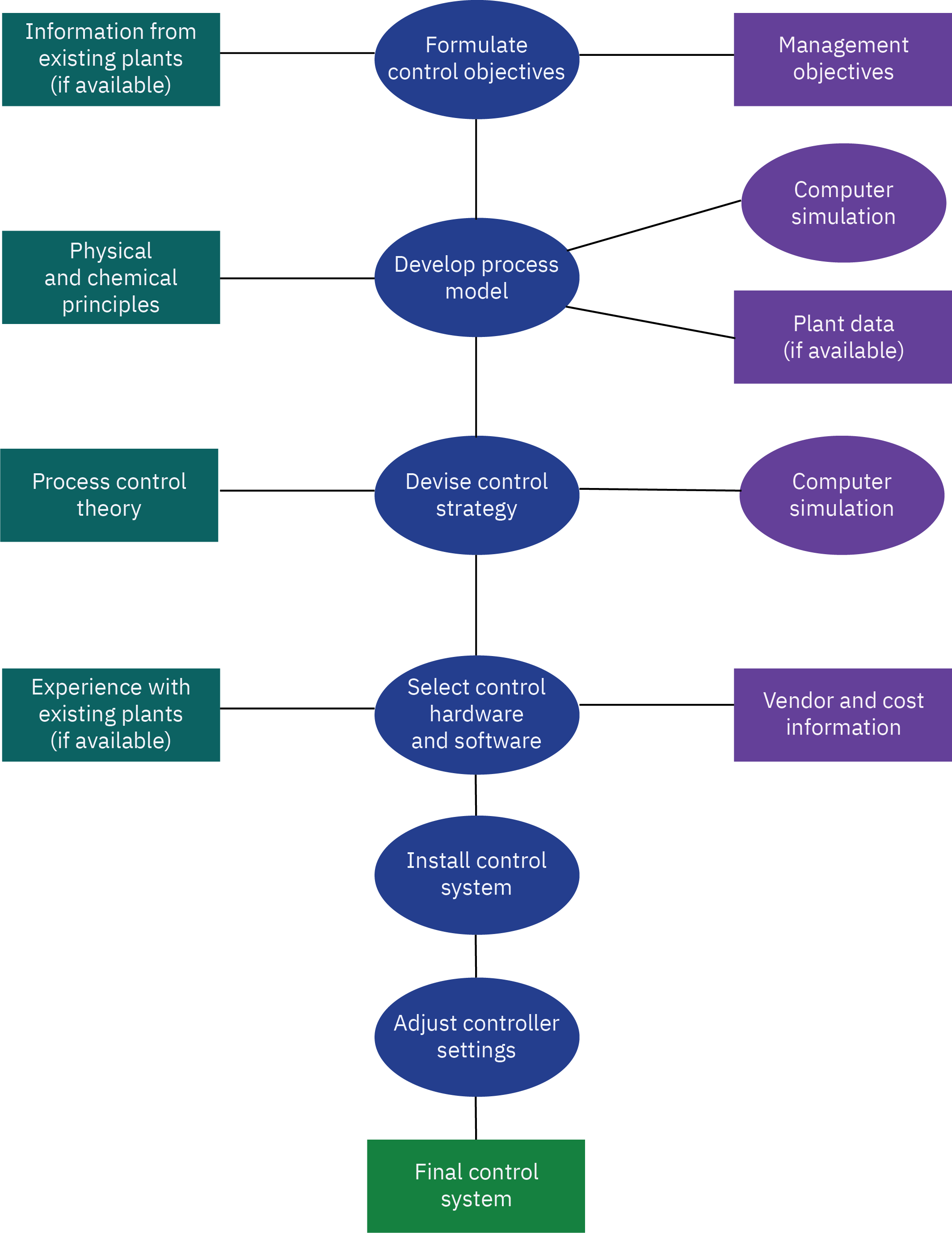
Fundamentals of process modeling
- Why process modeling?
- Types of process models
- Basic principles of mass and energy balances
- Process control terminology
Why process modeling?
Enhancing Process Understanding
Enable study of transient behavior without disruption
Provide valuable insights into dynamic and steady-state process behavior
Useful even before plant construction
Process Simulators for Training
Essential for training plant operators in complex units and emergencies
Create a realistic training environment when connected to process control equipment
Facilitating Evaluation of Control Strategies
Assist in identifying variables to be controlled and manipulated
Aid in preliminary controller tuning
Play an explicit role in model-based control strategies
Optimization of Operating Conditions
Recalculation of optimum conditions maximizes profit or minimizes costs
Utilize steady-state process model and economic data
Allow for continuous enhancement of process performance
Types of process models
Theoretical models
Developed using the principles of chemistry, physics, and biology.
First principles models
Mass, momentum, and heat balances
Empirical models
Obtained by fitting experimental data.
Statistical models
Correlations
data driven models
Semi-empirical/ hybrid models
A combination of the theoretical and empirical models
The numerical values of one or more of the parameters in a theoretical model are calculated from experimental data.

Basic principles of mass and energy balances
In general
accumulation=in−out−reaction−tranfer
Mass balance (without reaction and transfer)
{rate of massaccumulation}={rate ofmass in}−{rate ofmass out}
For component i (with reaction term included)
⎩⎨⎧rate ofcomponent iaccumulation⎭⎬⎫=⎩⎨⎧rate ofcomponent iin⎭⎬⎫−⎩⎨⎧rate ofcomponenti out⎭⎬⎫+⎩⎨⎧rate ofcomponent iproduced⎭⎬⎫
Basic principles of mass and energy balances
- Energy balance
{ rate of energy accumulation }={ rate of energy in by convection }−{ rate of energy out by convection }+⎩⎨⎧ net rate of heat addition to the system from the surroundings ⎭⎬⎫+⎩⎨⎧ net rate of work performed on the system by the surroundings ⎭⎬⎫
Blending of two components
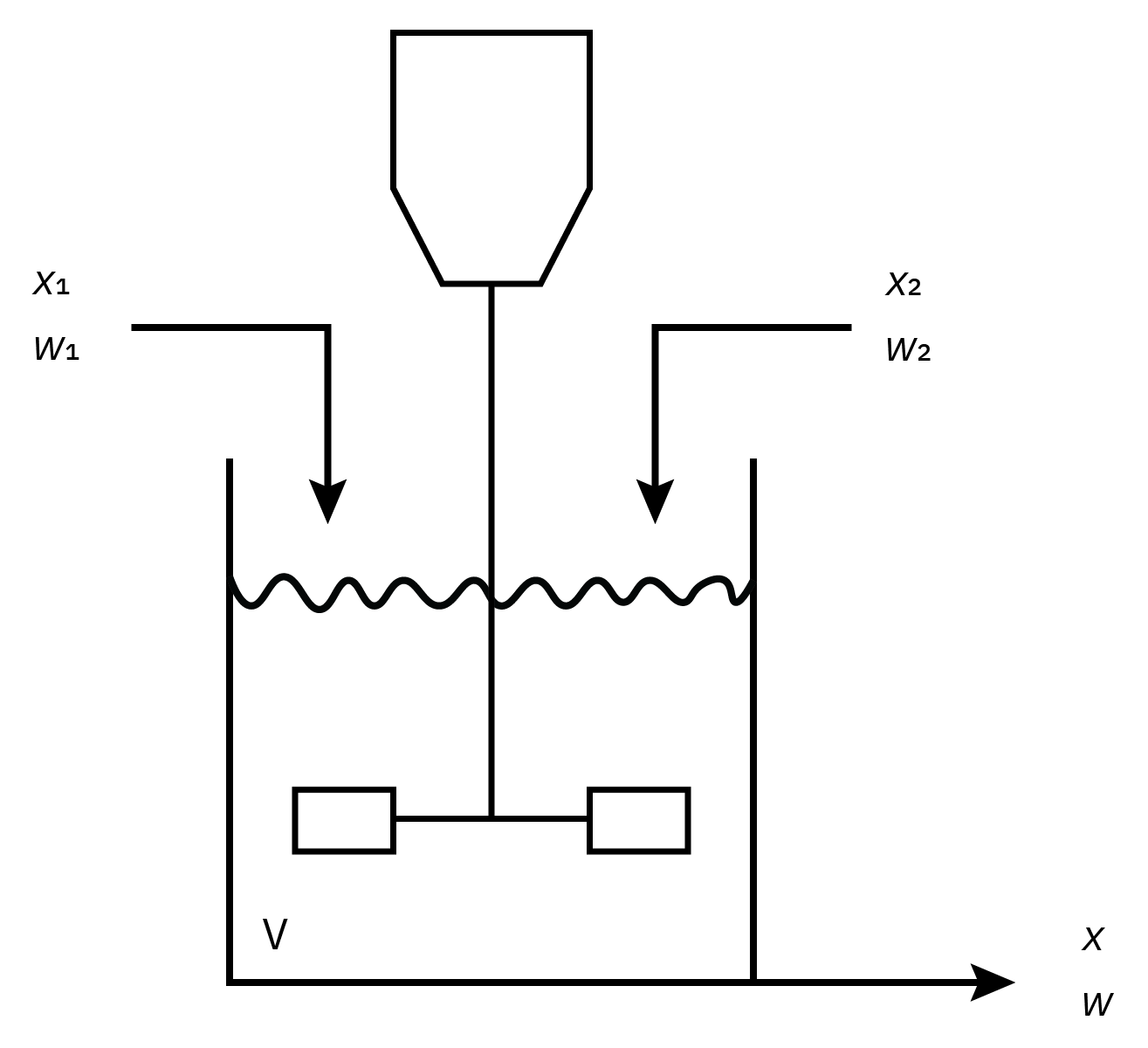
Overall mass balance
{rate of accumulationof mass in the tank}={rate ofmass in}−{rate ofmass out}
dtd(Vρ)=w1+w2−w
Component balance
dtd(Vρx)=w1x1+w2x2−wx
Blending of two components

Overall mass balance
{rate of accumulationof mass in the tank}={rate ofmass in}−{rate ofmass out}
dtd(Vρ)=w1+w2−w
Component balance
dtd(Vρx)=w1x1+w2x2−wx
It is possible to further simplify the system of two differential equations to
dtdV=ρ1(w1+w2−w)
dtdx=Vρw1(x1−x)+Vρw2(x2−x)
Degrees of freedom analysis
- To simulate a process, it’s crucial to confirm that the model equations, both differential and algebraic, form a set of relations that can be solved.
- For the model to have a unique solution, the number of unknown variables should match the number of independent model equations.
NF=NV−NE
- NF=0: The process model is exactly specified. If NF=0, then the number of equations is equal to the number of process variables and the set of equations has a solution. (However, the solution may not be unique for a set of nonlinear equations.)
- NF>0: The process is underspecified. If NF>0, then NV>NE, so there are more process variables than equations. Consequently, the NE equations have an infinite number of solutions, because NF process variables can be specified arbitrarily.
- NF<0: The process model is overspecified. For NF<0, there are fewer process variables than equations, and consequently the set of equations has no solution.
Solution of model equations
Nonlinear Chemical Processes: These result in complex ordinary differential equations when modeled.
Linear System Controls: These tools are well-established and provide valuable insights when processes operate near a specific point.
Laplace Transform: This simplifies creation of input-output models by converting differential equations to algebraic ones.
Transfer Function: An essential tool in control system design and analysis, representing linear control theory.

Empirical models
We can construct an empirical model using plant data
Assume a certain idealized model structure
First-order plus deadtime (FOPDT) model
Time domain form τpdtdy(t)+y(t)=Kpu(t−θp)
Frequency domain form (transfer function) Gp(s)=τps+1Kpe−θps
Kp: Process gain; τp: time constant; θp: deadtime
FOPDT model is often used in controller tuning. A transfer function is a mathematical formula that describes how a system responds to different inputs over time.
Second-Order plus Deadtime (SOPDT) Model
Time domain
τ2dt2d2y(t)+2ξτdtdy(t)+y(t)=Kpu(t−θ)
Frequency domain
Gp(s)=U(s)Y(s)=τ2s2+2ξτs+1Kpe−θs
Kp: Process gain; τ: time constant; θ: dead time; ξ: damping factor or coefficient
Behavior:
ξ>1: Overdamped
0<ξ<1: Underdamped
ξ=1: Critically damped
ξ=0: Sustained oscillations
ξ<0: Unstable
Dynamic Behavior of Processes
- Input types
- Response of first-order systems
- Response of second-order systems
- Properties of transfer functions
- Stability of linear systems
Input types
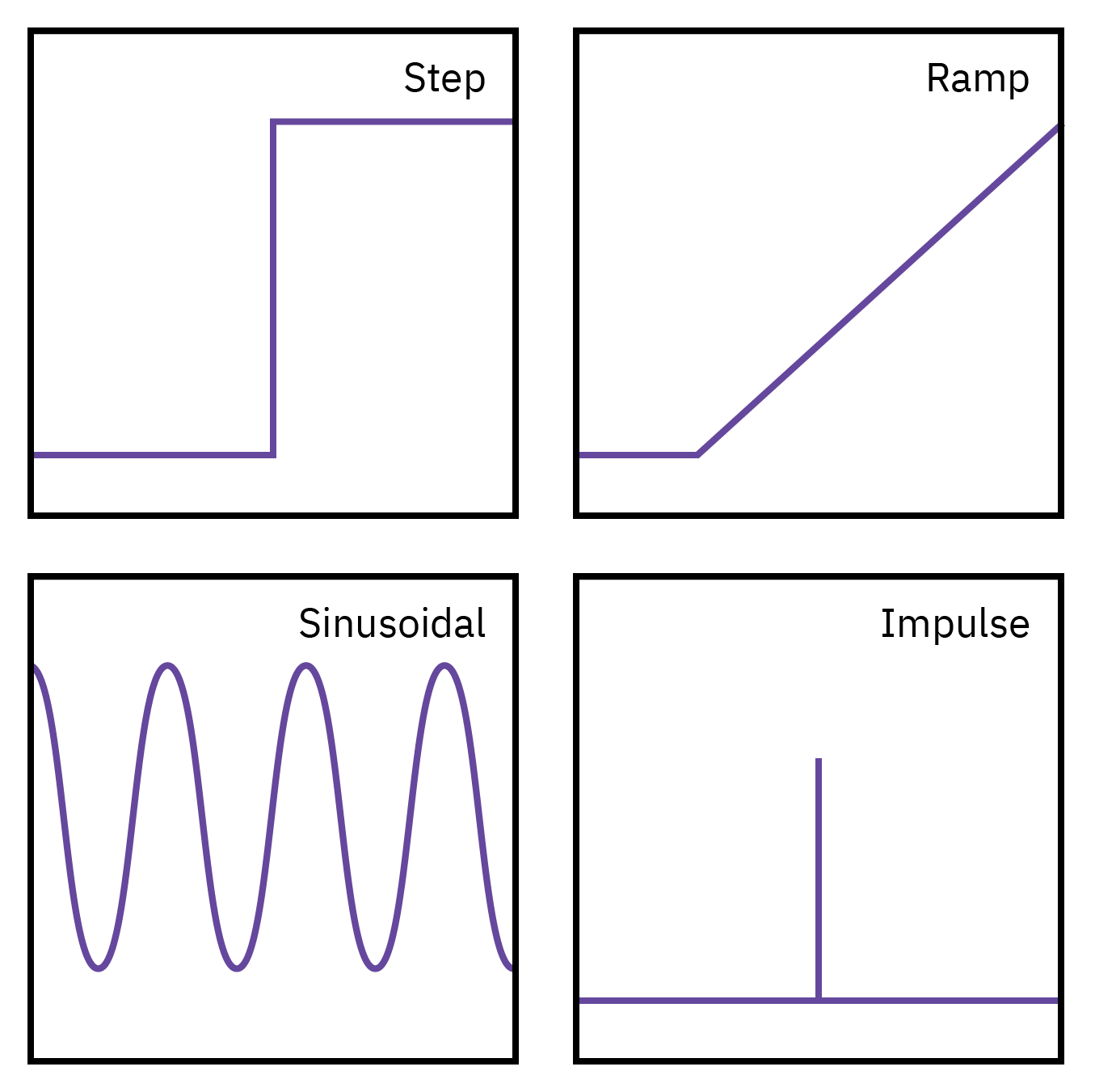
Response of first-order systems

Overall mass balance
Adtdh=Fin−Fout
Outlet flow rate, Fout has a square-root dependence on liquid level Fout=βh
Resulting nonlinear equation
Adtdh=Fin−βh
τdtdhˉ+hˉ=kFin;τ=β2Ah;k=β2h
Transfer function
Finˉ(s)hˉ(s)=g(s)=τs+1k
Process gain (k): Ultimate value of the response (new steady-state) for a unit-step change in the input.
Time constant (τ): Time necessary for the process to adjust to a change in the input.
Response of first-order systems
The ultimate (steady-state) value of the response, hˉ(t→∞), is equal to k for a unit-step change.
When the elapsed time is equal to the process time constant t=τ, the system reaches 63.2% of its final response.
After approximately 5τ, the transient response can be considered as having reached steady-state.
For a given t / τ, the output reaches the same fraction of the ultimate output response value.
In a tank process, a rise in the inlet flow rate elevates the liquid level, which in turn increases the hydrostatic pressure and subsequently the outlet flow rate. The system eventually reaches a new steady state. This feature is termed ‘self-regulation’.
Response of first-order systems
Response of second-order systems

Rise time (tr): time required for y(t) to first cross its new steady state value
Overshoot (a/b): The maximum amount by which the response exceeds the new steady state value
Decay ratio (c/a): Ratio of the height of successive peaks in the response
Period of oscillation (P): time for a complete cycle
Response/ settling time (ts): time required for the response to remain within a ± 5% band based upon steady state value.
Decay ratio, overshoot, response time, and damping factor (ξ) can be used as a basis for tuning.
Response of second-order systems
Critically damped (ξ = 1)
Output response becomes more sluggish as τ increases.
The responses are qualitatively similar.
Effect of ξ
ξ < 1: Oscillation and overshoot
ξ > 1: Sluggish response, no oscillations; no overshoot
ξ = 1: Fastest response, no oscillations; no overshoot
Properties of transfer functions
For transfer function
g(s)=u(s)y(s)=a0sn+…+anb0sm+…+bm=p(s)z(s)
The roots of the polynomial z(s) are the zeros of the transfer function or the zeros of the process.
The roots of the polynomial p(s) are the poles of the transfer function or the poles of the process.
A physical system needs to be proper (n≥m), and casual (output depends only on past inputs)
Characteristic equation
The denominator polynomial p(s) when equated to zero is called the characteristic equation:
p(s)=a0sn+…+an=0
Stability of linear systems
- The location of the poles of a transfer function determines the bounded input–bounded output (BIBO) stability of a process.
- If the transfer function of a dynamic process has a pole with a positive real part, the process is unstable. If the real part is zero, then the process is critically stable
- We need to be cautious when we derive a transfer function model from a statespace model, because a zero (or zeros) may cancel a pole (or poles). This becomes especially important if the canceled pole is unstable, which means that those modes of the process would be hidden from us.
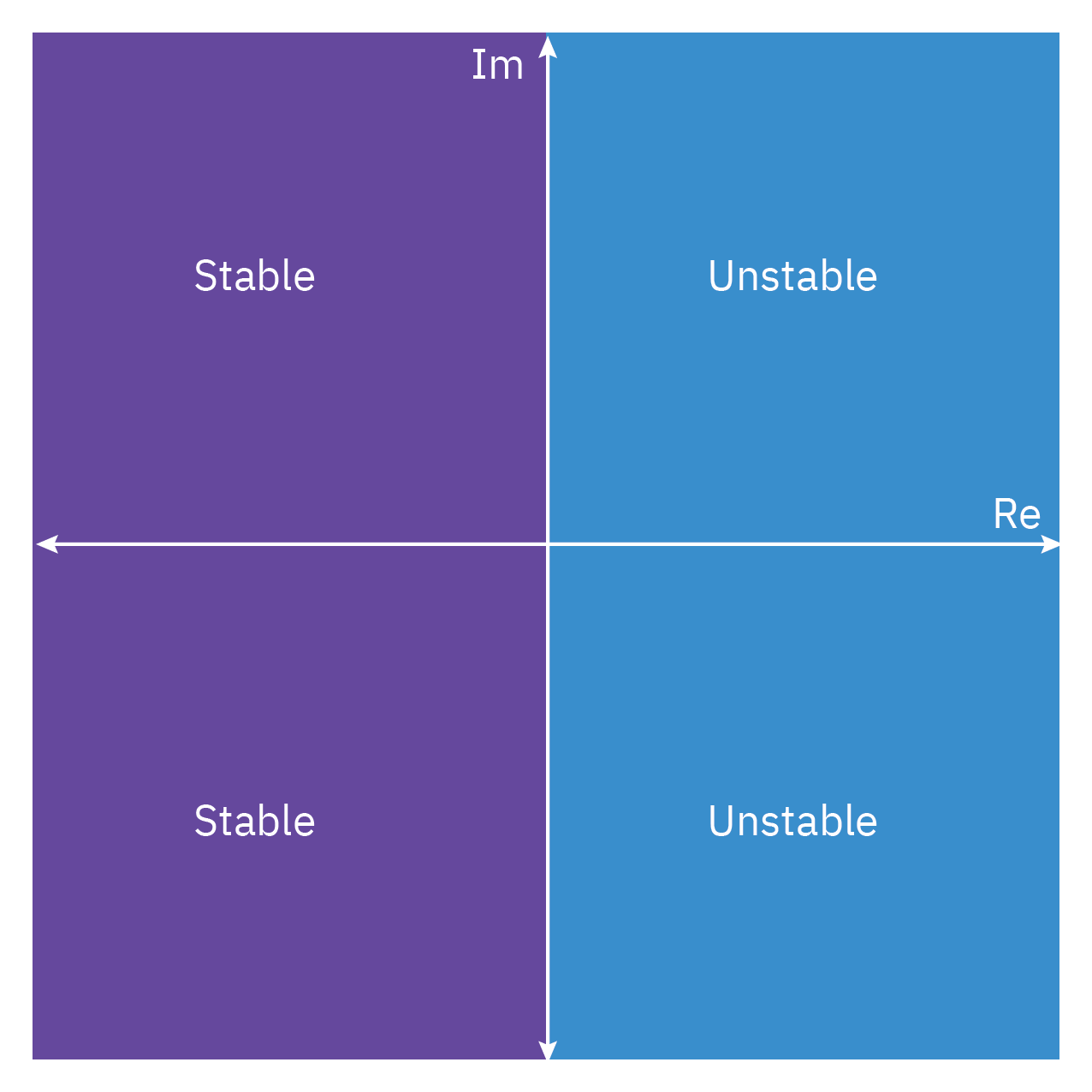
Routh’s Stability Criterion
Routh’s Criterion is a mathematical test that is used to determine whether a linear system is stable or unstable. It does not require explicit calculation of the roots of the characteristic equation.
Characteristic equation
a0sn+a1sn−1+a2sn−2+⋯+an=0
The first step in Routh’s Criterion is to set up the Routh array.
Then, we examine the first column of the array. If there are no sign changes in the first column, the system is stable.
If there are sign changes in the first column, the system is unstable. The number of sign changes corresponds to the number of roots with positive real parts.
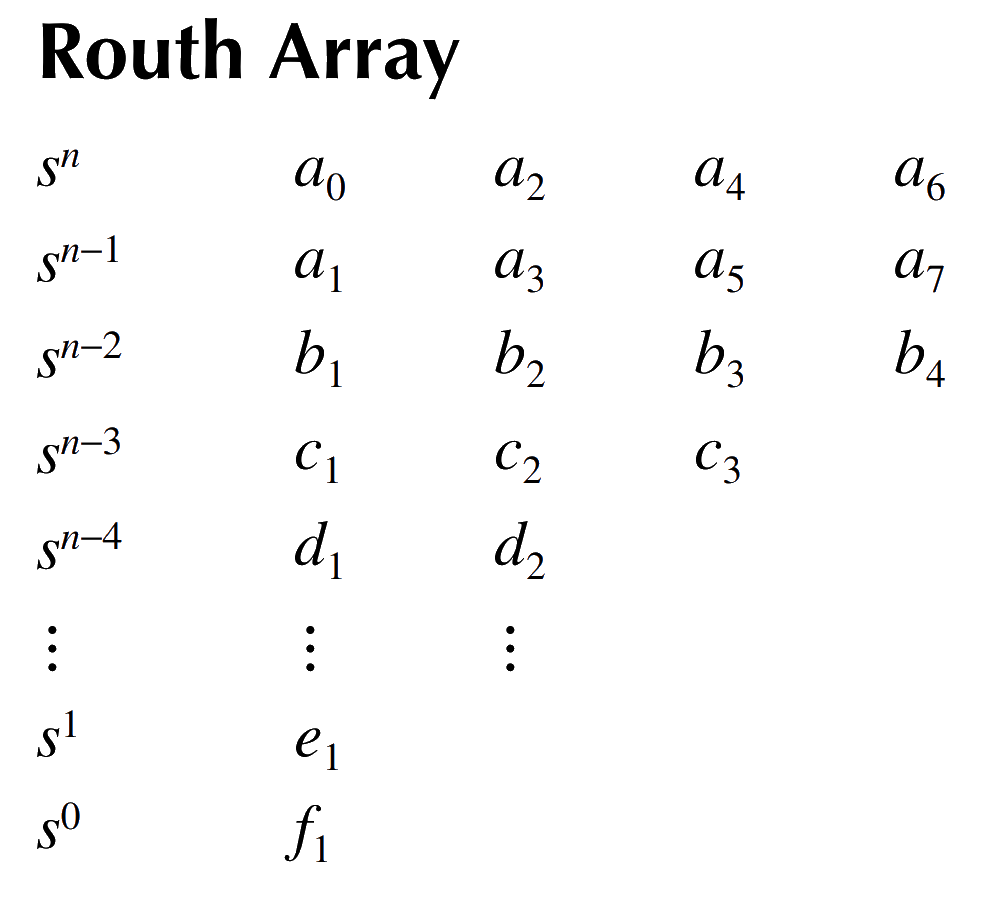
Routh’s Criterion can also be used to determine relative stability and system type.
Root locus method
Root Locus is a graphical method used in control systems to examine how the system stability changes with varying gain.
It shows possible pole locations as system gain varies from zero to infinity.
The method provides insights into stability and transient response.
Root locus begins at open-loop poles and ends at open-loop zeros.
The plot exists on parts of the complex plane where the number of open-loop poles and zeros to the right is odd.
Consider the characteristic equation p(s,k)=s2+s+k=0

Feedback Control Systems
- Introduction to feedback control
- Control law
- Proportional, integral, and derivative control actions
- Further topics
Introduction to feedback control

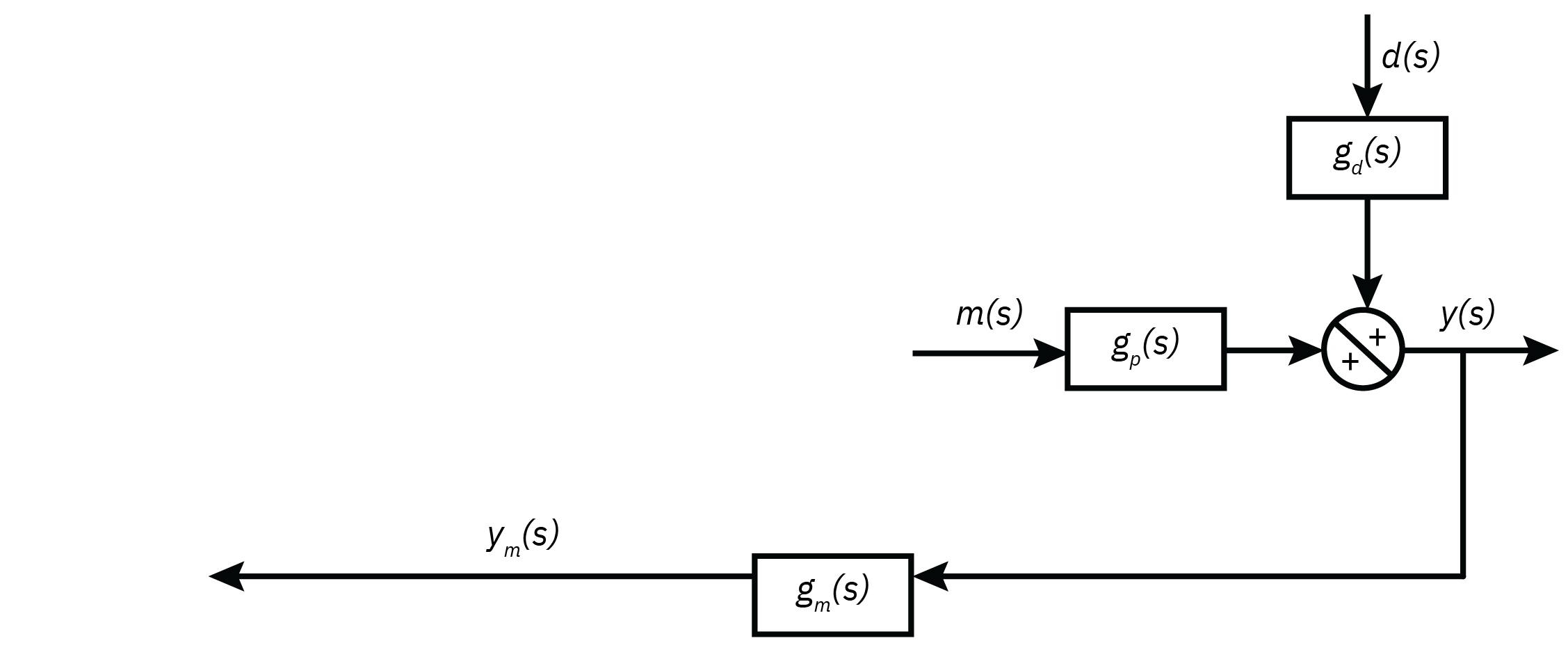
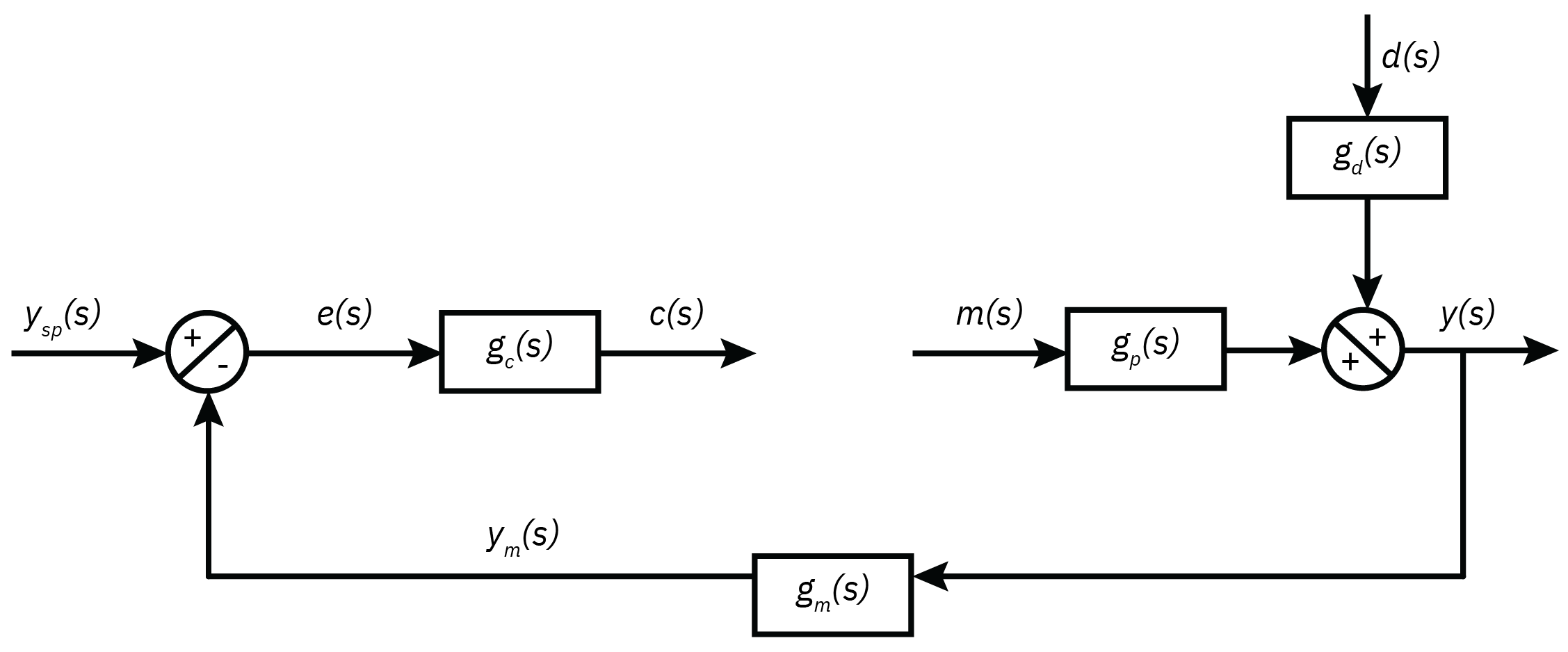
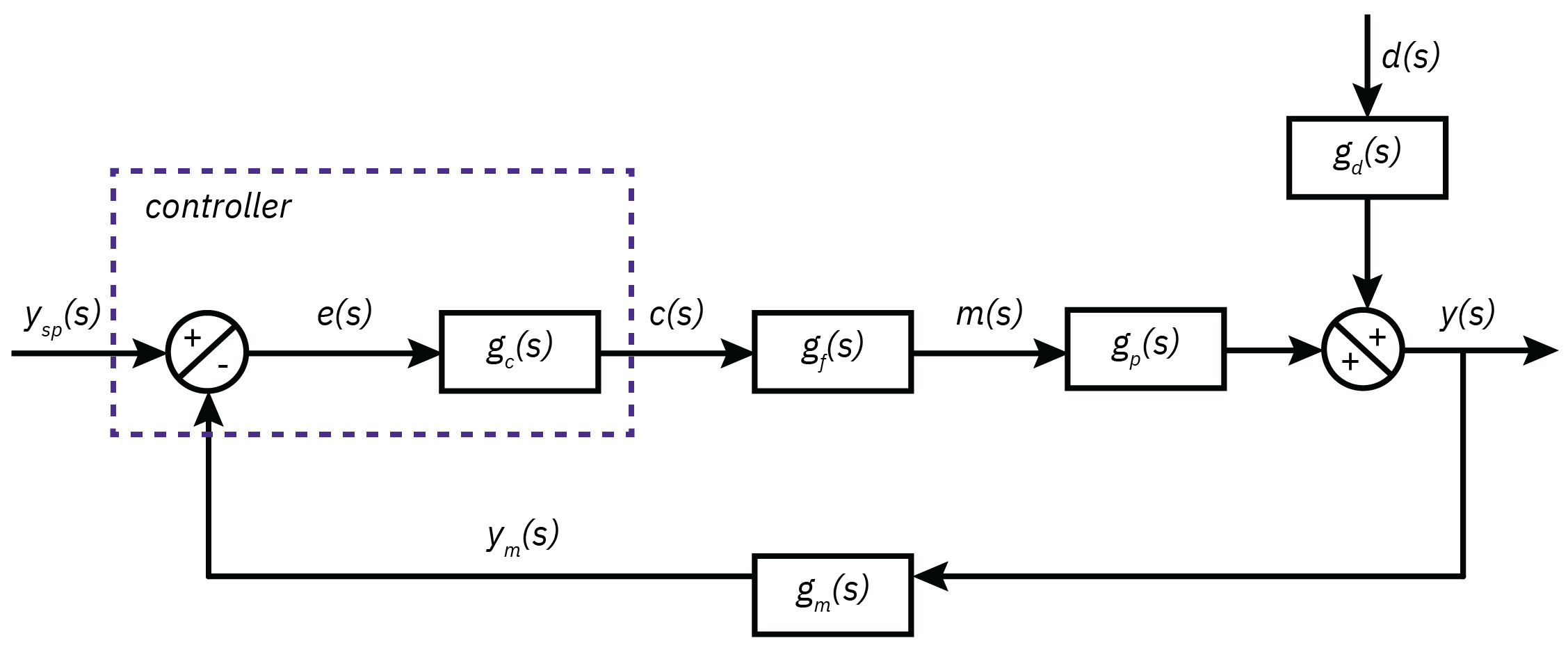
Introduction to feedback control
y=gpm+gdd
Error: e=ysp−ym
Control action: c=gce=gc(ysp−ym)
Manipulated variable: m=gfc=gcgf(ysp−ym)

Controlled variable: y=gpm+gdd=gcgfgp(ysp−ym)+gdd
Closed loop transfer function y=1+gpgfgcgmgpgfgcysp+1+gpgfgcgmgdd
Introduction to feedback control
y=Gspysp+Gdd
Gsp embodies the dynamics of the setpoint response.
How the process output will respond when the set-point is changed?Gd(s) indicates how the process output will respond when a disturbance enters the process.
Denominators of the closed-loop transfer functions, Gsp and Gd, are the same, indicating that they share the same stability characteristics.
In a more general setting, the closed-loop transfer function for general block diagram is represented as
ri(s)r(s)=1+G2(s)G1(s)
In this expression, r is an output variable or any internal variable within the control loop and ri represents an input variable such as ysp or d.
The transfer function G1 is the product of the transfer functions in the forward path that connects an input ri to an output r.
G2 is the transfer function composed of all transfer functions in the feedback loop.
Introduction to feedback control
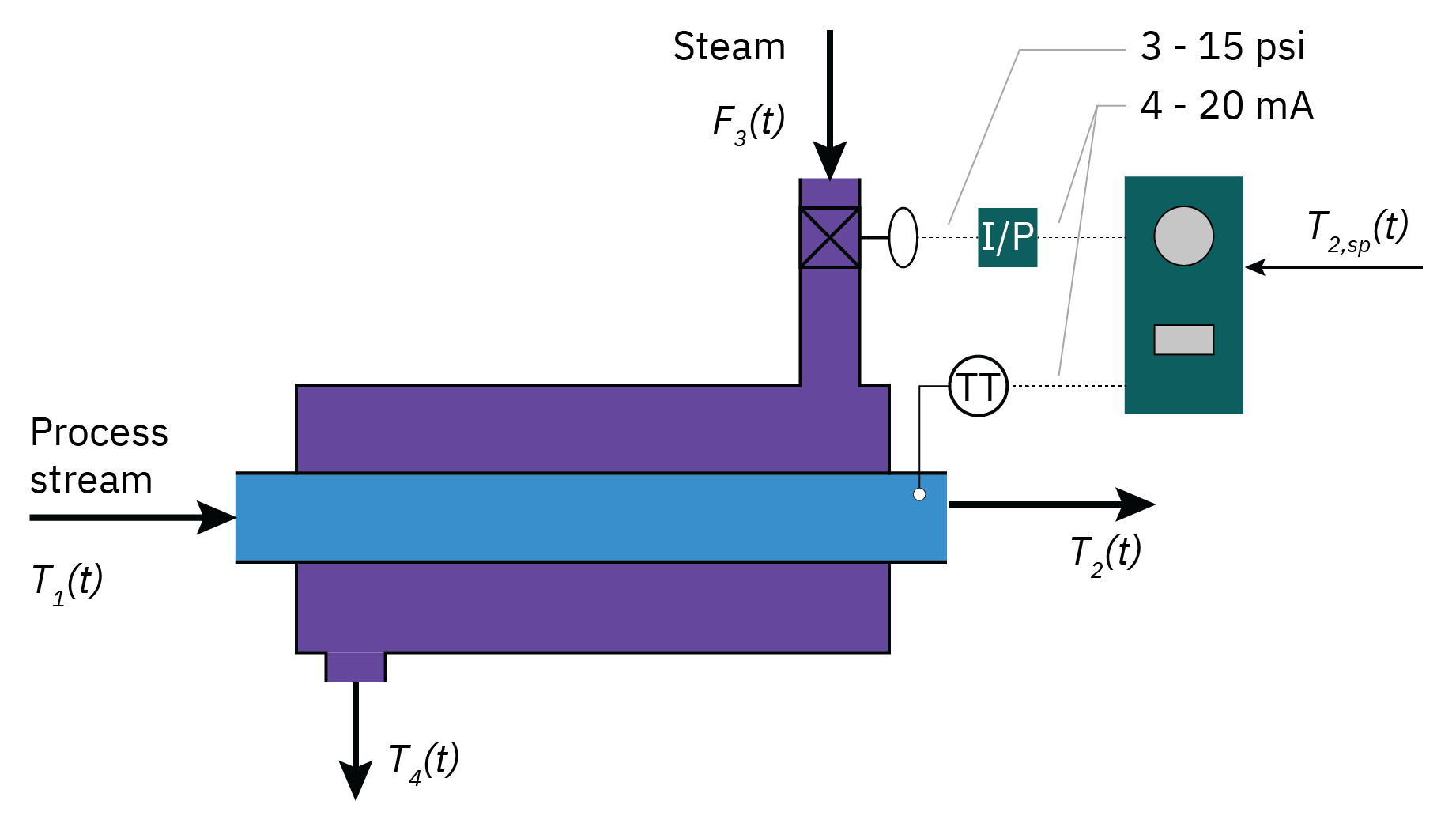
Introduction to feedback control
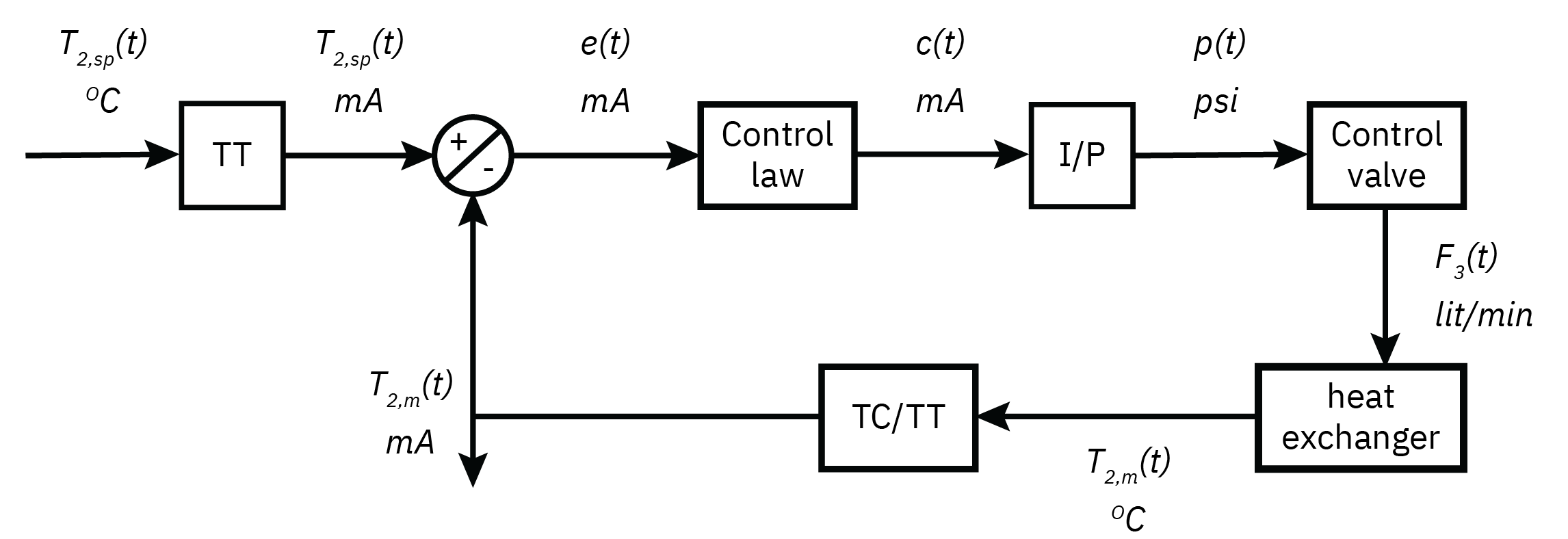
Control law
- The control signal c(t) is calculated, given the value of the error e(t), through a predefined functional relationship c(t)=C[e(t)]
- The function C[⋅] constitutes the control law.
- Establishes the manner with which the error information is processed by the controller.
- The most common functional form is the three-mode proportional–integral– derivative (PID) control law eˉ(s)cˉ(s)=gc(s)=kc(1+τIs1+τDs)
Proportional mode
- This mode produces a control signal that is proportional to the error: c(t)=kce(t)+cb
- kc represents the proportional gain of the controller: Defines how sensitive the controller is to errors present in the system.
- cb is a bias signal that corresponds to the value of the control signal when the error is zero. The bias signal is the steady-state value of the control signal.
- Define - deviation variable cˉ(t)=c(t)−cb; also eˉ(t)=e(t)
- Transfer function: eˉ(s)cˉ(s)=gc(s)=kc
Proportional mode
Integral mode
- The control signal for this mode is produced by the integral equation: c(t)=τIkc∫e(t)dt+cb
- The new parameter τI represents the integral time constant or the reset time.
With this mode, the controller responds effectively to errors that build up over time.
This is a very important feature because even if the error is small, as long as it persists, a large control signal may be calculated, thus helping to eliminate the error quickly
- The transfer function of a controller with only the integral mode is eˉ(s)cˉ(s)=gc(s)=kc(τIs1)
Integral mode
Derivative mode
- In this mode, the control signal responds to the rate of change of the error signal: c(t)=kcτDdtde(t)+cb
- A new parameter τD is introduced as the derivative time constant.
The role of this mode is to judge the change in the error.
For instance, if the error is still present but not increasing as fast, the controller may use this information to decrease the control signal, thus possibly avoiding overly aggressive control actions.
- The transfer function for a controller with derivative mode only is given by eˉ(s)cˉ(s)=gc(s)=kc(τDs)
Derivative mode
Mixing tank
The manipulated variable is the flow rate of stream 2, F2, to control the outlet mass fraction, x.
The disturbance is the flow rate of stream 1, F1.
The feed mass fractions are assumed constant.
There is a P controller, gc(s)=kc.
The dynamics of the actuators and the sensors are accounted for by pure dead-time elements, resulting in the transfer functions
xˉ(s)=2.5s+1−0.1e−sFˉ1(s)+2.5s+10.1e−sFˉ2(s)

Mixing tank: setpoint change
Mixing tank: disturbance rejection
Further topics
Model liniarization
Controller design and tuning methods
Frequency response analysis
Bode plots and Nyquist plots

Advanced Modeling and Control